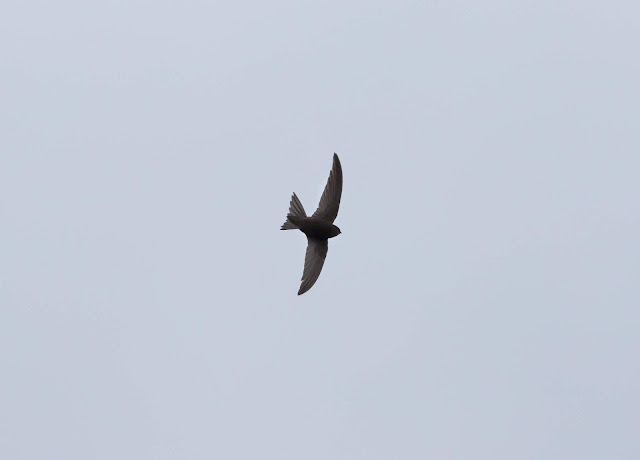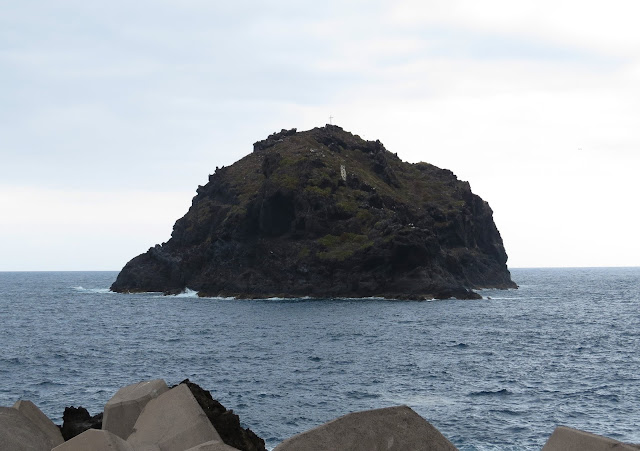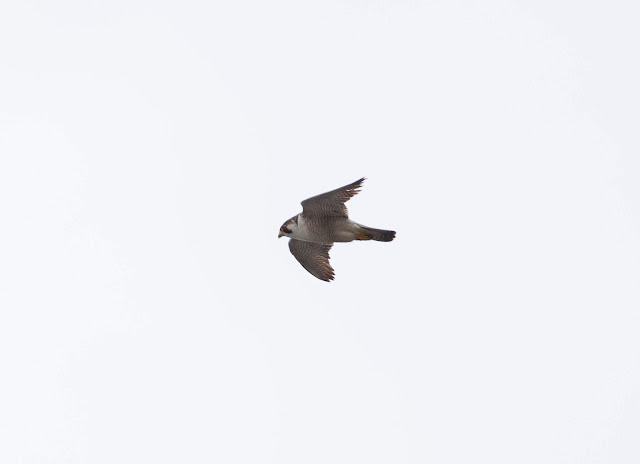Our third morning on Tenerife dawned slightly greyer than our previous two days, with thick cloud cover enveloping Los Cristianos and Playa de Las Américas where we were staying. Unperturbed and with Barbary Falcons to track down, we decided to head back up to the north of the island and search any likely sites where these hard to find birds of prey might be likely to occur.
 |
| The view from the Barranco de Ruiz |
Our first point of call was the well-known Barranco de Ruiz, a small viewpoint off the side of a twisting mountain road near Las Rosas that offered extensive views of the valley below. A huge gorge dating back millions of years and sporting an impressive list of endemic flora and fauna due to the high humidity and falling fog moisture the area receives, Barranco de Ruiz is also a key site for both Bolle’s and Laurel Pigeons. Right on cue, it wasn’t long before several of the latter powered in to view, swooping lower down in the ravine and touching down in the depths of the thick tree canopy lining the rocky outcrops.
 |
| Laurel Pigeon in flight - one of many |
White tails and dark bodies visible even at such a long range, we had around 8 birds in total during our visit, but yet again not a single Bolle’s – that first bird at Mirador de La Grimona had proved vital!
Barranco de Ruiz also provided us with our best views of Plain Swift to date, with hundreds of birds swirling en-masse right above our heads at the top of the steep gorge, taking advantage of the glut of insects the low cloud was bringing out, shrieking and playing manically. Impossible to photograph due to their sheer speed and close proximity, we had to make do with a memory card full of blurred dark shapes as they whizzed by!
 |
| Plain Swift |
With the usual Canary Island Chiffchaffs and Atlantic Canaries joined by a small charm of Goldfinches flitting through the trees by the car, a singing Quail was a nice surprise, its familiar “Wet my lips” call emanating from somewhere further down the rocky slope but remaining well hidden in the thick, lush vegetation.
Once more however, it seemed that the Barbary Falcons were going to evade us yet again, a solitary Buzzard and a pair of Kestrels the only birds of prey in the area. Just as we were giving up hope and with a thick mist and clouds descending rapidly over the valley, a slightly larger pair of falcons caught our eye, circling in the far distance over the furthest cliffs bordering the ocean. Straining our eyes through our scopes they looked extremely good candidates for Barbary, but the distance was just too extreme and we failed to pick out any distinguishing features. There was therefore only one thing for it, and we were soon heading back down the mountain to the coast in an attempt to intercept and catch up with our possible Barbary Falcons.
 |
| Charco Verde - prime Barbary Falcon habitat |
Hurtling down the TF-342 to try and reach the spot it looked like they had been circling over (it was extremely hard to get our bearings from where we were looking at the top of the Barranco!) it came as a huge surprise when at the bottom of the road a mid-sized falcon came barrelling over the road just feet above our car, peachy buff undersides in plain view and with distinctive thick pointed wings reminiscent of a Peregrine - surely a Barbary. Vanishing over the small rocky crags on the opposite side of the road and out of sight, we made an emergency detour down one of the small farm tracks at Charco Verde, scouring the skies above the extensive banana plantations for further signs of our falcon.
 |
| Not the most picturesque of locations! |
Eventually, we caught sight of it again at the end of the track overlooking the ocean, frustratingly flying out of view again over the banana plants before we could get better looks or photos. Thankfully, our luck was in, as after a few minutes not one, but two birds soared back in to view, one individual exceptionally close over the adjacent bananas and providing crippling views.
 |
| Barbary Falcon - finally! |
Taking a look through bins the distinguishing features were obvious, each bird sporting a rusty brown and black cap and the buff hue of the underside we saw earlier again clear to see. With Peregrines only very rarely occurring on Tenerife, but with a handful of records making it over, it felt good to positively nail the ID 100% and secure much better views – finally Barbary Falcon as a bogey bird had toppled.
With the afternoon ahead of us and having mopped up all our targets, we decided to head over to the nearby Charco del Viento for a spot of seawatching, stopping off at the Cepsa petrol station near the Mirador de La Grimona for a quick snack before we left and scoring an impressive 15 Laurel Pigeons swooping along the cliff face in the ten minutes we were there.
 |
| Laurel Pigeon perched outside the Cepsa petrol station |
Having chosen this location due to its proximity near to Las Aguas, Charco del Viento seemed as good a spot as any to try for Barolo (Little) Shearwater, famed as being an extremely difficult species to get on Tenerife.
 |
| Roque de Garachico nearby - once the site of breeding Barolo Shearwaters |
Traditionally looked for on the Tenerife – La Gomera ferry, even this failsafe option has become very hit and miss in recent years, with fewer and fewer birds seen and many visits drawing a blank. With a number of recent records emanating on the northern coast around the seaside town of Las Aguas where birds have been reported as heading out to feed towards the early evening, we set up position and waited for the sun to start to set.
Two Canary Islands Chiffchaffs flitting amongst the fleshy cactus stems kept us company as we waited, while a pair of Berthelot’s Pipits surprisingly took a fancy to a crumbled up lemon muffin we’d put out optimistically, providing our best views yet of the Macronesian speciality.
 |
| Berthelot's Pipit enjoying a lemon muffin |
A constant stream of Cory’s Shearwaters passing by also kept us entertained, and we notched up counts of over 200 birds over the course of the afternoon. As the sun started to set, almost on cue we had our first ‘non Cory’s’ of the day that sparked our excitement – a small Manx type powering east over the waves. Just about managing to keep it in the scope as it sped past, the bird was just too fast and distant to get any of the key features expected of Barolo (the rounded wings, white face with dark eye standing out, nor the silvery-grey edges to the wings).
Barolo Shearwaters will also usually fly low down over the waves and often raise their heads in a bobbing motion during flight, again a feature we just couldn’t make out. Over the course of the evening we counted a further 14 individuals, all following the same pattern and exhibiting the same flight style, height, colouration and size. At no point did any of the birds observed scream out “Barolo Shearwater” and at no point did we wonder If we’d got one – they all just looked like bog standard Manx Shearwaters.
Checking out other observers notes and observations it was clear that Manx Shearwaters are not uncommon in Canary Islands water, and without anything to suggest otherwise, we were both confident in saying that we definitely didn’t have any Barolos fly past during the evening.
With the last of the blood red rays of the sun setting behind the Atlantic expanses and the hopes of finding any Barolos extinguishing with them, we decided to call it a day and head back to the hotel. Despite the disappointment on the shearwater front we were more than pleased at having scored with our Barbary Falcons, and were more than ready to tuck in to a well-earned meal of Indian spiced chicken and seafood pasta at the next door Pizzeria – delicious. With all our targets now safely under our belts this meant we could take our foot off the gas and relax for our final two days, exploring the scenery and beaches that Tenerife offers at our leisure.
























No comments:
Post a Comment